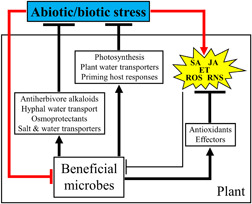Figure 2.

Beneficial microbes counteract plant stress responses and protect hosts from stresses. Abiotic and biotic stresses induce stress responses in plants that are governed by signalling molecules including salicylic acid (SA), jasmonic acid (JA), ethylene (ET), reactive oxygen species (ROS) and reactive nitrogen species (RNS) (Pozo et al., 2015). Plant beneficial symbionts are affected directly by abiotic/biotic stresses or indirectly by plant stress responses (i.e., SA‐, JA‐, ET‐, ROS‐ and RNS‐associated responses). These symbionts protect themselves from plant stress responses by the production of antioxidants that reduce ROS‐ and RNS‐derived oxidative damage and fungal effectors that efficiently repress defensive hormone‐ and ROS‐associated host responses. Additionally, plant beneficial symbionts protect from stresses by producing stress‐protective mechanisms (e.g., antiherbivore alkaloids, osmoprotectant molecules) and/or inducing plant tolerance/resistance mechanisms against stresses (e.g., photosynthesis, priming of plant immune responses). The symbionts' mechanisms that counteract plant stress responses or protect plants from stresses are described in the main text. Arrows indicate positive regulation and truncated lines inhibition or negative regulation. Red connectors denote direct effects of stresses on plants and beneficial microbes. The plant regulation of beneficial microbes is represented with a thinner truncated line since plant stress responses may be attenuated by the microbial production of effectors and increase in antioxidant levels in plants. [Color figure can be viewed at wileyonlinelibrary.com]
